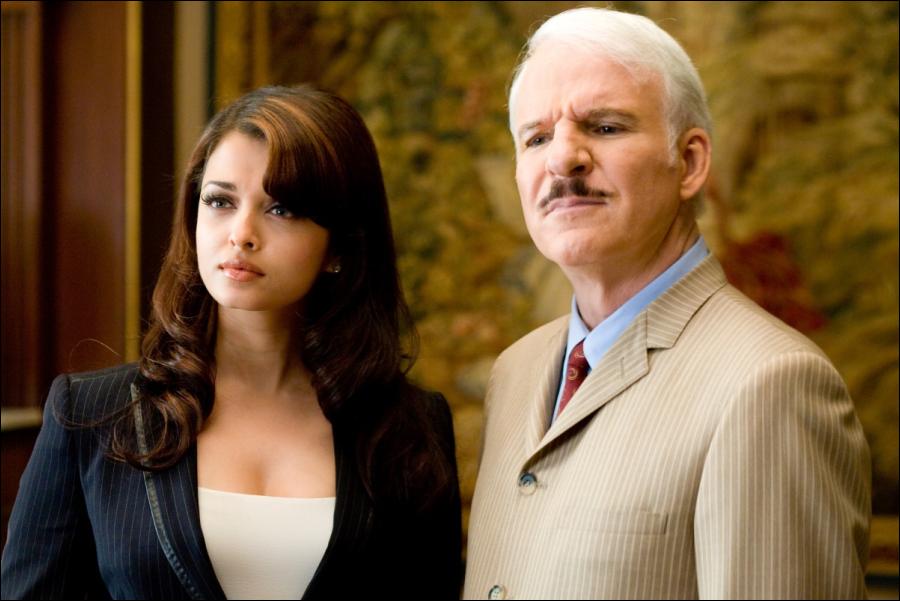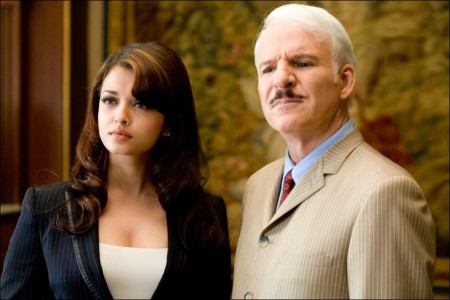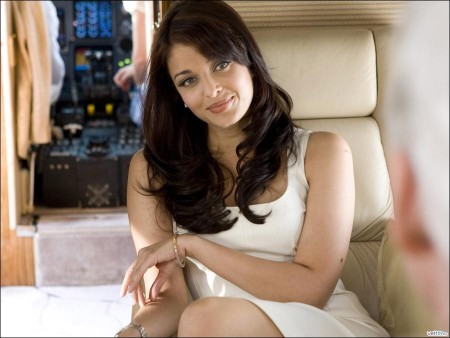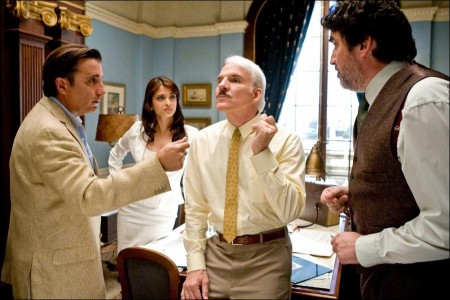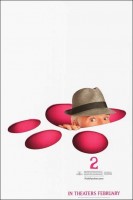“Steve brings Clouseau a really interesting combination of vulnerability and self-assurance,” Simonds continues. “He’s got a gift for physical comedy, but he is also incredibly erudite. He possesses an incredibly sophisticated sense of humor with an underbelly of big laughs. Just as importantly, his comedy is ironic and smart but never mean-spirited. All the comedy in the Pink Panther films is at the expense of Clouseau, who is simply trying to maintain his dignity in all these situations. Thanks to Steve’s performance, not only is the movie very funny, but audiences are emotionally invested in Clouseau.”
Director Harald Zwart adds, “People love Clouseau. He has a huge heart, and though he makes a lot of mistakes, it all comes from naïve clumsiness. He’s always trying his best – it’s just that his best is never good.”
Emily Mortimer, who is back for seconds as Nicole – the object of Clouseau’s awkward affections – notes that the two films with Martin as Clouseau fit in perfectly with the rest of the franchise. “This character that resonated in the 1960s still has an appeal now. There’s something about this complete nincompoop who manages to save the day that people find appealing.”
“What Steve’s done, which is so brilliant, is not to do an homage to Peter Sellers but to retain the spirit of Clouseau and keep the very best of it – the essence of it,” says Alfred Molina, who joins the cast as Pepperidge, a member of the Dream Team of detectives that forms when the master thief, The Tornado, comes out of retirement to steal the world’s most famous treasures. “He’s taken the character and our collective memory of the character and made it his own.”
Not everyone is as enamored with the qualities of the character. “I have met people like Clouseau in England,” says John Cleese. “We call them `pronoid’ – the opposite of paranoid. They think that everyone likes them and is on their side, when there is no evidence for this whatsoever. And I think Clouseau is like that. Clouseau has no idea that people can’t stand him – he doesn’t realize he’s a pest.”
It’s hard to deny that the overzealous Clouseau can be a pest, but the actor playing him is altogether admired by his colleagues. “I love working with Steve,” beams Simonds, with whom Martin also worked on Cheaper by the Dozen. “He’s a brilliant man. He’s smart, he’s honorable, he’s hardworking, and he’s ferociously committed to making every joke as fresh as it could possibly be.”
Jean Reno emphasizes, “It’s not only the character that made me want to return as Ponton, it’s the friendship between Steve Martin and myself. I like him very much as an actor, a human being, and a philosopher, as an artist in fact. He’s somebody who knows completely the work of being an actor and making people laugh. We made a great team in the first Pink Panther, so I was very happy to make this movie with him, to be part of the adventure, to be Ponton again.”
“Steve is just fabulous and I definitely have a Nicole-type crush on him in real life,” says Mortimer. “He loves the experience of being Clouseau – it’s infectious. It’s a real pleasure and an honor just to watch him do his stuff. What’s interesting is that he’ll play Clouseau, then – after the director calls `cut,’ the real Steve is an incredibly sophisticated, serious person who knows everything about art and writes novels and for the New Yorker! How much more grown-up can you get than that?”
“I think Steve has the greatest comedy mind of anyone I’ve met,” says John Cleese. “When I was editing A Fish Called Wanda, he came to one of the viewings and when we went out to dinner afterwards, gave me the best set of notes that anyone gave me in my life. So this is a man with a great comedy mind. We are always saying how suddenly you see part of his genius–how he delivered the sentence and how he created a moment, a magical moment, and then you laugh and you don’t know why.”
Helming the production is Harald Zwart. “The Pink Panther is a franchise that everyone is familiar with,” he says. “The approach to this film, with the dream team of detectives sparring with Clouseau, was fantastic, and I know that Steve was even more familiar with the character this time around. For all those reasons, it was an exciting project.”
The On-Screen Dream Team
The filmmakers hit upon the idea of accentuating Clouseau’s bumbling by surrounding him with a dream team of detectives from around the world. “I think Clouseau seems funniest when he’s surrounded by highly competent, really smart people,” observes Simonds.
An esteemed international cast has been assembled for The Pink Panther 2. In addition to Jean Reno and Emily Mortimer, who return to their roles as Ponton and Nicole, respectively, several highly respected and funny actors join the cast, including John Cleese, Lily Tomlin, Andy Garcia, Alfred Molina, Yuki Matsuzaki, and Bollywood star Aishwarya Rai Bachchan.
“The entire cast is very generous,” says Jean Reno. “We each felt we were lucky to be a part of the collaboration. Everybody was in the same mood, everybody was on top of their game.”
Alfred Molina agrees; “It was a very collaborative atmosphere. Somebody would come up with an idea and we’d say, `Oh yeah, let’s try that.’”
Ponton and Nicole
It was very important to the filmmakers that the actors playing Ponton and Nicole, Clouseau’s two closest associates, return for The Pink Panther 2. Clouseau’s relationships with both, now clearly established, are developed in the sequel in funny and touching ways. Steve Martin says, “Though Jean and Emily aren’t necessarily known for comedy, they both do it really well.”
Reno says that the setup of The Pink Panther 2 kept Ponton’s relationship with Clouseau open for many comedic possibilities. When his wife throws him out of the house for seeming to care more about work that his family life, Ponton moves into Clouseau’s bachelor pad (along with his two boys and dog). “Suddenly,” notes Reno, “the two men are pushed into Odd Couple territory. Somebody is coming to your house with the two kids, the dog, and completely making a revolution to your life. But, I think, nobody can really enter into the interior life of the character of Jacques Clouseau. Ponton knows that you must respect this or otherwise you break the dream, you break the fantasy of Jacques Clouseau, who is something untouchable.”
Producer Robert Simonds observes, “Jean Reno is one of the most soulful people you’ll ever meet. He’s able to convey so much with just a twinkle in his eye.”
Though he cuts an imposing figure, Reno is regarded by his castmates as one of the kindest and funniest people on set. “Jean Reno and I remained good friends after the first movie. I love him,” says Martin. “He’s a delightful guy who is always joking and kidding around.”
“Every day, he said `good morning’ to me in Japanese – he speaks a lot of Japanese,” notes Matsuzaki. “Jean is well known in Japan as a very cool, very serious action-hero type, but actually, he is a nice, funny man. Up until the moment Harald calls for `Action’, Jean tries to entertain us.”
Emily Mortimer also returns to play Nicole in the sequel. The Nicole-Clouseau relationships heats up in 2, flamed on one side by the jealousy fueled by Vicenzo’s attentions and on the other by the betrayal Nicole feels when she walks into her own office and finds Sonia in Clouseau’s arms (even if he was only comforting her!).
Mortimer says that stepping into the role of Nicole doesn’t require quite as much acting as she lets on. “It is worryingly easy to access my inner Nicole,” she says. “There’s definitely a side to me that’s Nicole-esque. Although I pretend not to be, I’m slightly hapless myself. On the set, one of the actors would say to me, `Oh, I loved what you did in that scene – it was so funny,’ and I’ll have this moment where I realize that whatever it was, I hadn’t done it on purpose.”
Of course, by identifying with her character, Mortimer raises the comic potential in every scene. “Everything in the movie is slightly ridiculous, but if you can relate to what Nicole is going through on a real level, it heightens the scene. Nicole is in love with Clouseau and isn’t sure if he loves her back. They’re both protecting themselves from their real feelings. Steve and I play the scenes between them with both feet off the ground – when you understand that Nicole is just a girl in love, it’s easy to tap into her emotions.”
Producer Simonds says that though Mortimer sees herself as part of the antics, she actually provides an in-road for the audience. “Emily is so bewitching and charming. Her character is so grounded, she becomes Clouseau’s emotional tether in the film. She does such an unbelievable job of being in love with this out-of-control character that she becomes the access for the audience.”
Dreyfus
Taking on the role of the Clouseau-hater Chief Inspector Dreyfus is comedy legend John Cleese. “I think there’s something funny about a man who is quite clearly and genuinely bright and competent and in charge of his life, who, through terribly bad luck, is constantly bested by someone who is a bumbling incompetent. When they came and asked me to play Dreyfus, I thought, how do I do this? And then I thought of my predecessors, Herbert Lom and Kevin Kline, and, well, they were both dreadful, so I’ll just try and do it reasonably well. And people have noticed the difference!”
Kidding aside, Cleese says it was a pleasure to be a part of a Pink Panther movie. “I’m old enough to remember going to a cinema in Leicester Square to see the first Pink Panther – and thinking it was just so sophisticated. Claudia Cardinale, Cappucine, David Niven, and of course, Sellers, who’s a comedy genius. The English have always found the French accent very funny – I don’t know why.”
“I had Steve Martin and John Cleese – two of the biggest comedic geniuses – together on the monitor on the set of a film I was directing. I had to pinch myself,” says Zwart. “But you’ve got to watch out for John Cleese There were practical jokes all the time on the set.”
“It is personally an unbelievable experience to get to work with John,” says Simonds. “He plays pompous funnier and better than anybody – as Dreyfus, he couldn’t be more perfect. Watching him and Steve, two comedy legends playing off each other, was a complete blast.”
The Detectives
Joining the cast to play the dream team of detectives are Andy Garcia, Alfred Molina, Yuki Matsuzaki, and Aishwarya Rai Bachchan.
Garcia plays Vicenzo, an Italian detective who joins the team after the Shroud of Turin falls into the hands of The Tornado, the master thief stealing the world’s most famous artifacts.
“I love doing comedy,” says Garcia. “My early training and experiences on stage in Los Angeles were in improvisational comedy groups and troupes – it’s something I enjoy very much. So when this opportunity came up – knowing that I would be involved not only with Steve and Jean and Emily, but Alfred and Lily and John Cleese – it was something I wanted to do.”
“Andy is a blast,” praises Simonds. “His character, Vicenzo, is a formidable playboy; when Andy walks onto the set, he’s got such a sense of power and control that without him having to even open his mouth he exudes his character.”
His co-stars praise his dedication and wit. “When I first met Andy I thought he’d be a really serious guy,” says Matsuzaki, “but when I have scene with him, or even when he’s off camera, he takes care to help his fellow actors be good on film.”
Alfred Molina plays Pepperidge, “a very British, stiff character,” he says. “His expertise is in forensic science and deduction.
“I really wanted him to wear heavy tweeds,” says Molina, hinting that the clothes would make the man. “Joe Aulisi, our costume designer, wanted to be sure I was OK with wearing such heavy clothes in Boston in the summertime. As it turned out, we were there in late September and when those fall breezes started shooting up the river, I was fine.”
“Alfred is wicked and wonderful and just so amiable-he’s a special person,” says Rai Bachchan. “He’s a great, wonderful actor, which is obvious from the varied performances he has given, and then again, he’s just spontaneously funny.”
Rai Bachchan plays Sonia, the surprise addition to the dream team as an intriguing expert on the life of The Tornado. Rai Bachchan, one of the biggest stars in India and often considered one of the most beautiful women in the world, is set to breakthrough as a huge star in America and around the world.
“Aishwarya,” smiles Jean Reno, “the green eyes, the beauty! Wow. The surprise it is that she has a big sense of humor, always laughing, which is fantastic for a beautiful woman. And she is always ready to act.”
Rai Bachchan points out that Sonia, a writer and authority on the Tornado, is a valuable asset. “Since Clouseau and his dream team are on the lookout for the Tornado, they perceive her as someone who would have valuable knowledge. She thereby slides in and becomes one of them – a welcome member of the team. It’s neat and smooth.”
“You’ll see her in person, and you say, `Wow, that’s a really beautiful girl,” observes Simonds, “and then you look at the monitor and she’s translucent. I can’t imagine anybody who we would have had play Sonia other than her. She is so charming, intelligent, funny and powerful – she lights up the whole frame.”
Reinforcing that the Clouseau series of films are an international phenomenon, Rai Bachchan emphasizes that this film “is familiar terrain; people know The Pink Panther in India. In fact, when I was cast, there was a spontaneous reaction from people where they were just happy for me be a part of this film.”
Did the Indian movie star find shooting an American film in Paris and Boston very different from moviemaking at home in India? “No, I have never looked at it as different. I think each experience remains individual depending on the director and the core team members that make the movie-irrespective of the language it’s being made in.”
Yuki Matsuzaki rounds out the team as Kenji, who he describes as “a Japanese detective who’s a specialist in computer programming and computer security systems. Sure, he is a computer geek (in Japanese we say `otaku’), but he doesn’t think of himself that way. It’s just a usual thing for him and he tends to think that other people can understand everything he understands. He gets so excited when he’s found some facts and wants to share the joy of it, but other people can’t understand at all.”
“Yuki is very sweet, genuine, respectful and enthusiastic,” praises Rai Bachchan. “It’s so nice to see someone who is this excited about his work, so willing to contribute and be a team member. That kind of spontaneity and innocence is special and it would be wonderful to see him be able to retain it.”
Matsuzaki performed some behind-the-scenes roles in the film, crafting the front page of the Japanese newspaper used to announce the great thefts as well as helping the actors playing Japanese news reporters perfect the dialogue spoken in his native language.
Martin and Tomlin
The Pink Panther 2 marks the reunion of Steve Martin and Lily Tomlin, two great American comic actors. Simonds recalls, “I was unaware that Steve and Lily hadn’t actually been together on screen in twenty years, since All of Me. To watch the two of them riff on each other was so much fun. A ten-second scene could go on for three or four minutes and just get funnier and funnier and funnier. Their chemistry is phenomenal.”
The duo was thrilled to be reunited. “We have the same sense of humor,” says Martin. “When we did our scenes it was very natural and very improvised. We had the script, but we also went off and went kind of crazy. Lily and I don’t pal around, but whenever we see each other it’s like old times. It’s a funny thing about the movie business, you meet people and then you don’t see them for three or four years and then you just pick up where you left off.”
Tomlin says that her character provides a natural foil for Clouseau. “Mrs. Berenger has been hired to instruct all the employees at the Palais de Justice in political and social correctness,” she says. “And of course, Clouseau is a prime student, because he’s so gauche, bless his heart, he just doesn’t get it. He doesn’t get that you don’t comment on a woman’s body, or you don’t refer to certain races and ethnicities in some kind of degrading vernacular. It’s very easy to reprimand Clouseau, because in so many ways he’s a dolt. In other ways he’s so charming. And it’s frustrating, I must say, because he doesn’t really get it no matter what we do with him, because he has a kind of innocent charm – it’s almost like he just never was socialized in the right way.”
Her character, she continues, is “rather upper-class American, cultured, well-spoken, educated, a little pretentious. There is a sense of power in being able to speak very, very appropriately and very perfectly.
The Pink Panther World
The Panther filmmakers chose to create a timeless, classic, romanticized, tourist, picture-postcard world-a Paris of sidewalk cafes, flower vendors, street artists and strange-looking cars, influenced by such sources as Madeleine, The Red Balloon, the films of director Jacques Tati, and Ratatouille. While the film is surely set in modern Paris, its anachronistic elements, including the many classic, colorful cars that now only zoom around the Arc de Triomphe in movies, are decidedly intentional.
“Clouseau is a French icon,” observes executive producer Ira Shuman, “so we wanted him to live in that storybook French world – not the new, high-rise, metal and glass Paris, but the city we all know and love.”
Director of photography Denis Crossan, BSC, who collaborated with director Harald Zwart on Agent Cody Banks, adds, “Clouseau’s world is contemporary, but he’s kind of in his own universe; as soon as you take him into a real-life situation where it’s slightly gritty or real, it doesn’t seem to work. So my starting point was to give it the feel of a Hollywood world and the décor and the costumes have added to that.”
Creating that Hollywood world through the costumes, according to costume designer Joseph G. Aulisi, meant working with “real clothes, but off-kilter due to a change in proportions,” he says. Now in his sixth collaboration with Steve Martin, Aulisi says that the actor has a very clear idea of what he wanted to express through Clouseau’s clothes. “We did a four-button jacket with a very small lapel, tiny collars, narrow ties, long, exaggerated shoes, pants and sleeves that are too short, hats with small brims and strange colors. All of this adds to the humor, because of what Steve could do with it with his body language.”
Production designer Rusty Smith, who also worked with Zwart on Cody Banks, says, “Harald was really interested in paying homage to Jacques Tati, the French comic and director, and tried to give the film a retro or nostalgic feel. Even though we have modern microphones and DNA analyses, it takes place in its own time. For the design, we wanted to maintain the beautiful, idealized flavor that Lily Kilvert brought to the first film.”
Smith also integrated such classic elements as the curved art nouveau lines of Clouseau’s home and the entrance to his apartment building (added to an already existing façade in Paris) and the iconic artwork hanging on the walls, the Monet cathedrals at the party, Jean-Louis David’s “Death of Marat” in Avellaneda’s den and paintings and his “Napoleon Crossing the Alps” along with busts of the Emperor that help define the décor of Dreyfus’s office. Smith gives credit for finding the “film’s many fabulous antiques to my brilliant set decorator, Carla Curry, with whom I’ve worked for several years.”
“This is a world seen through Clouseau’s eyes,” says costume designer Joseph Aulisi, “so it’s a fairytale environment that’s slightly heightened, slightly more amusing than things normally are. I came up with some things that I think are rather timeless and classic but are grounded in the wonderfully defined characters.”
The film’s audiences are dazzled by the array of classic vehicles that grace Pink Panther 2’s Parisian streets, most notably the blue 1968 Citroen DS 19 driven at the beginning of the film by the angry motorist who rejects Clouseau’s parking ticket and drives off with the Inspector attached to his car. Propmaster Jennifer Gerbino recalls, “Harald showed me a picture of that car and said he’d had one as a young man. As luck would have it, I found it in less than an hour on line and bought it a few hours later in Massachusetts, where most of the film was shot. The prop department in Paris was forced to match my car-since it would easier to find a match in France than vice versa.”
The filmmakers also populated their streets with such vehicles as a 1957 Glas Goggomobil, a 1972 Fiat Polsky, a 1962 Renault Dauphine, a 1952 Austin A30, a Vespa Ape P501 “Floriste” truck, and a 1972 Citroen 2CV. The fire trucks that are called to put out a blaze are Unimogs and Pinzgauers, traditional Swiss and EU emergency vehicles. The US-based crew found these vehicles in Cumberland, Rhode Island, where a company imports them, converts them to American standards, and sells them to Americans as recreational vehicles.
A Symphony of Accents
Since the characters in the film speak a great assortment of accents, “we had to make sure that everybody kept their accent in a fairly tight box,” emphasizes Simonds. “The most outrageous accent would always belong to Clouseau. Our phenomenal dialect coach from the first film, Jessica Drake, returned for another tour of duty, and she really helped provide an anchor.”
“It was fun to get back into the accent,” notes Martin. “I love to have a coach. I think I have my own sound to the accent, but I have to say that Jessica is really good.”
“The challenge of learning a dialect will vary from person to person and really depends on their background,” notes Drake, who started out as an actor and formally studied speech and dialects at the Juilliard School and other institutions. “In the first film, we had only variations of French. In The Pink Panther 2, we have Steve, who is very American, doing a wonderful French accent with its unique Clouseauesque twist. His Clouseau French is heightened; it’s its own animal and unique to Steve. He can get a joke out of taking a sound, twisting it around and making it hysterically funny all by itself. Emily, who is British, is doing a fluffy French accent as a complement to Clouseau. Andy, who is Cuban-American, is doing an Italian accent, and Yuki is doing Japanese. Alfred, who is English, is doing a very proper, nose in the air, upper-class Queen’s English, and Aishwarya is speaking her own beautiful Indian-British sound.”
“The English have always found the French accent funny,” observes John Cleese. “I don’t know why we find it so funny. We recognize the others, the Russian and the German, but we just laugh at the French accent. Steve and I discussed whether I should use an accent. I’d assumed that I would do a French accent, because I’ve done so many, especially by the French Taunter in Spamalot, but I suddenly thought, no, it may be better if Steve is the one with the French accent. I suggested that to him on the day we first shot and I think a look of relief flickered across his face. It’s better to create these little contrasts.”
“I’ve been living in the States now for fifteen years,” says Molina, “so I think a little bit of the British is gone, but what I’m trying to do is take the a British accent and heighten it and make it a bit more exaggerated to give it some comic value.”
“I studied English and spent years trying to get rid of my accent,” says Matsuzaki, who was born in Japan and now lives in Los Angeles. “But in this movie, my task was to put back the broken Japanese as much as I could. This influences my performances – since Kenji’s English ability isn’t that great, he tends to think before he comes to that precise word he would like to say.”
Garcia says, “Accents are always challenging, because first you have to understand them and get comfortable with them to the point where you don’t have to think about them anymore. You want to be free of the consciousness of having to do the accent. It should just come out of you naturally like in your own voice.”
Jean Reno’s goal was “to be clear in front of the American audience. Even if I already have the accent,” he laughs, “I have to be clear. My wife, Zofia Moreno (who plays a reporter in the film), is English, so she helps me a lot.”
“Considering the fact that today’s audience is really multinational,” notes Rai Bachchan, “I think the accents work very well. The world is only getting smaller, so I think it makes a lot of sense. It’s a clever idea.”
Mortimer notes the underlying giddy absurdity of the accents. “Under the creative circumstances,” notes Mortimer, “one doesn’t feel quite so responsible for producing the perfect French accent, for it would, in fact, be a bit wrong in the context of this movie to be doing a brilliant French accent, because, after all, we’re French people talking to each other in English with bad French accents–that’s part of the joke!”
About the Production
The first week of shooting The Pink Panther 2 took place in Paris. The cast and crew traveled to the Eiffel Tower (for the scene re-introducing Clouseau), the Pont de l’Archevéché behind Notre Dame Cathedral (the press conference during which all of the detectives but Clouseau announce the identity of the Tornado), an old street in the Marais district (Clouseau’s apartment building), the Chateau Ferriere outside of Paris (the Avellaneda estate), Ecole Nationale Supérieure d’Arts et Métiers (exteriors for the Palais de Justice and the Vatican) and notably Le Petit Palais (the exterior for the climactic party scene) and Le Grand Palais-the huge, recently renovated exposition center built more than 100 years ago in which the cinematic Pink Panther Diamond is on display.
From Paris, the production moved to Boston, which production designer Rusty Smith calls “A quintessentially European-American city with a heavy Parisian influence.”
“It’s movie magic when you enter a door in one country and exit in another country,” says Smith. “My favorite example from this film is after the car that Clouseau’s been trying to ticket drives off beneath the Eiffel Tower, we immediately cut to it driving down a street in Boston, dressed like Paris. I’d found the location one late night in Boston when I’d stumbled across this square [Winthrop Sq.]. It was totally deserted and I felt like I was in Paris. It was just magical. After you dress it, bringing in flower stalls, cafe tables and other Parisian elements, even the locals were walking up to the set going, Wow.
Other Boston locations include the Boston Public Library (the Pope’s Bedroom-for which Smith notes “we had to have scale. The balcony from off this room is sixty feet in the air and it’s huge–the window is eighteen to twenty feet tall. So finding a room that would be ornate enough was a major challenge. The Boston Public Library is just an amazing piece of Italianate architecture!”); the Massachusetts State House (the three rooms from which the great treasures are found stolen in the opening sequence were created in the MA capitol building’s Nurses Hall–the British Library, Memorial Hall–the Shroud’s display in Turin, and the quotidian-sounding Massachusetts Hearing Room, for the more exotic museum in Kyoto); the Crane Estate in Ipswich, MA (Avellaneda’s estate) and, most notably, the Wang Center in the Citi Performing Arts Center-a 1920s- era theatre whose lobby was used for a full week to film the climactic party sequence-“We needed scale, marble and gold,” notes Smith, “and the Wang Center just had everything!”
Production notes provided by Columbia Pictures.
The Pink Panther 2
Starring: Steve Martin, Jean Reno, Emily Mortimer, Andy Garcia, John Cleese, Alfred Molina, Molly Sims, Aishwarya Rai, Yuki Matsuzaki
Directed by: Harald Zwart
Screenplay by: Lowell Ganz
Release Date: February 6, 2009
MPAA Rating: PG for some suggestive humor, brief mild language and action.
Studio: Columbia Pictures
Box Office Totals
Domestic: $35,922,978 (49.2%)
Foreign: $37,108,397 (50.8%)
Total: $73,031,375 (Worldwide)
